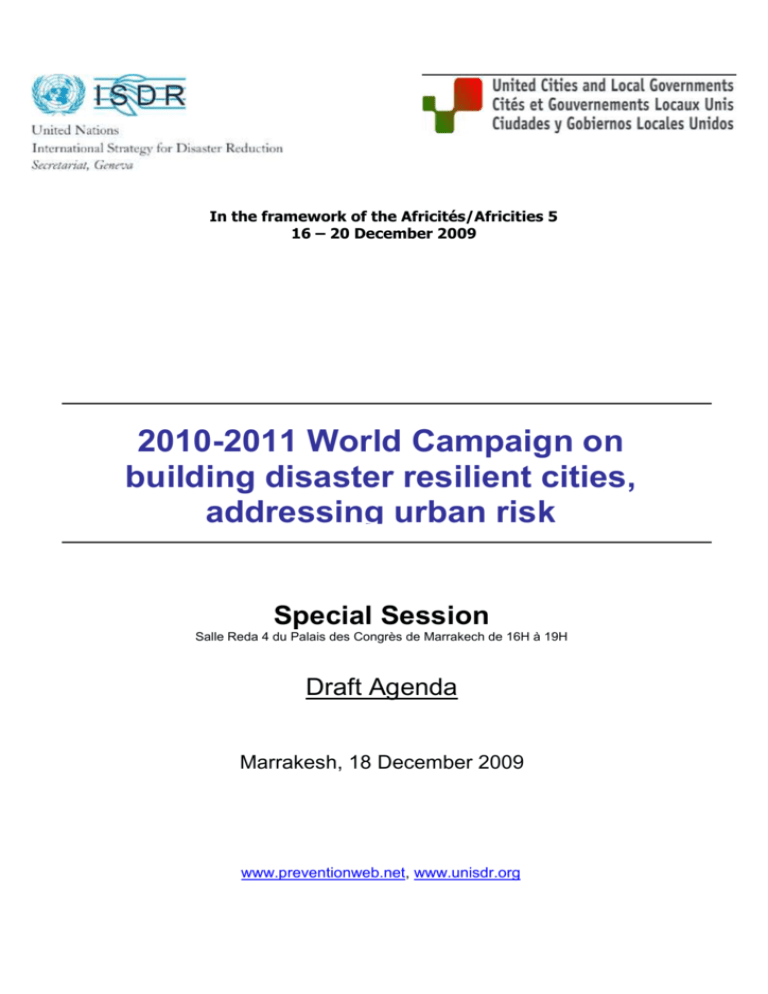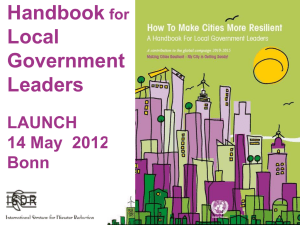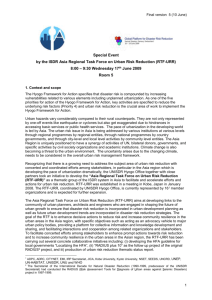Draft agenda of the special session
advertisement

In the framework of the Africités/Africities 5 16 – 20 December 2009 2010-2011 World Campaign on building disaster resilient cities, addressing urban risk Special Session Salle Reda 4 du Palais des Congrès de Marrakech de 16H à 19H Draft Agenda Marrakesh, 18 December 2009 www.preventionweb.net, www.unisdr.org Background Risks to climate related and other disasters are increasing rapidly, causing wide spread damage in urban areas during flash floods, coastal floods or landslides, killing hundreds of urban dwellers, and affecting the livelihoods of thousands/millions . Many cities in Africa have been drastically aware of these increasing problems over the last years, in West Africa, the Horn of Africa, and recently in the landslide disaster in Cairo. Earthquakes have damaged cities in Algeria and Morocco (damaged cities) during the last years. A large and growing proportion of Africa’s population now lives in urban centres, more than 350 million people, which represent around two fifths of Africa’s population. A very small proportion live in ‘mega-cities’ (only Cairo has more than 10 million inhabitants). Most live in relatively small urban centres. The growing urban population in Africa has already begun to reshape the geography of disaster risk and scope for reducing that risk- each nation have different characteristics to its cities or urban centres. “Key characteristics of most African cities (by D. Satterthwaite): high proportion of the population living in poor quality and overcrowded housing in informal settlements and working in the informal economy many informal settlements on hazardous sites (e.g. at risk from floods, landslides, earthquakes, fires…….) risk-levels much increased by the lack of infrastructure and services in many residential areas local governments that are ineffective in taking the measures that can reduce risks” Globally, these trends are linked to unplanned urban development, ecosystems decline and failing infrastructure, such as insufficient storm drainage and failing building stocks and lack of proper local governance set-ups to deal with disaster risk. Local government officials are faced with the threat of disasters on a day-to-day basis and need new policies and tools to effectively deal with them. Risks are exacerbated by disease, industrial accidents, and the impacts of climate change that are aggravating the vulnerability conditions of urban dwellers. United Nations, with United Cities for Local Governments and partners, is launching a Global Campaign to build disaster resilient cities – as part of the International Strategy for Disaster Reduction The goals of the campaign are to foster new partnerships between local communities, local and national authorities, and different expert groups to: Know more: increase awareness about urban risk and how to apply disaster risk reduction measures, also to address climate change adaptation. Learn from local communities and cities that have done good Invest smarter: raise political awareness among decision makers both nationally and locally, and by private sector, to invest in development that actually do not increase risk levels Build safer: promote use of risk assessments, building standards and access to safe land to protect people and critical infrastructure such as safer schools, hospitals and sound drainage systems Objectives of the Special Session during Africities, 18 December: Present the World Campaign and partnership to Mayors and local authorities in Africa, and discuss how to best apply it to African cities. Discuss what the role is for Local Governments to reduce risk in their cities, and what are the opportunities and barriers. Learn from some lessons 2/5 Seek commitment from partners to promote the Campaign in Africa, next steps. ___________________________________________________________ Draft Agenda (16:00 -19:00) Coffee will be available 16:00 – 17:00 World Campaign- setting the stage Presentation of the scope and objectives of the World Campaign for disaster resilient cities. Helena Molin Valdés, Deputy Director, UNISDR Building and Alliance of local governments to reduce disaster risk- how to get involved Rev. Ebukalin Sam L'Kwisk, District Chairman, Bukuedea District Local Government, Uganda Questions and answers 17:00 – 18:00 Role of local governments to reduce risk – examples, what works and what are the challenges. A panel discussion of three-four Mayors covering different angles according to their views and experience Mr Adam Kimbisa, Mayor of Dar es Salam, Tanzania Mr Tariq Kabbage, Mayor of Agadir, Morocco, Mr. Cheikh Dieye, Mayor of Saint Louis, Sénégal. Discussion, questions and answers 18:00- 19:00 Commitments and wrap-up on next steps Two local government representatives will introduce their ideas (tbd), followed by a moderated discussion on how to take next steps to develop a partnership in Africa to address urban risk and the Campaign- identify “champions” Rev. Ebukalin Sam L'Kwisk, District Chairman Helena Molin Valdés, UNISDR _______________________________________________________ MODERATOR: Mr. Mohamed Boussraoui", UCLG secretariat _______________________________________________________ Venue: Salle Reda 4 du Palais des Congrès de Marrakech, 18 December 2009, 16H à 19H For more information: Ms. Helena Molin Valdes – UNIOSDR secretariat Email: molinvaldes@un.org, Mobile: +41-79- 217 3060 Mr. Michele Cocchiglia – UNISDR secretariat Email: cocchiglia@un.org, Mobile +41 (0)76 5183 498 Mr. Mohamed Boussraoui, UCLG secretariat m.boussraoui@cities-localgovernments.org 3/5 About the organizers The United Nations International Strategy for Disaster Reduction secretariat (UNISDR) Adopted by United Nations Member States in 2000, The International Strategy for Disaster Reduction (ISDR) is a global strategy aimed at coordinating the efforts of a wide range of actors to reduce disaster risks and build a “culture of prevention”, as part of sustainable development. The secretariat to the Strategy, the UNISDR , serves as the focal point in the United Nations system for the coordination of disaster reduction and works towards disaster risk reduction becoming integral to sound and equitable development, environmental protection and humanitarian action. The motto for UNISDR is “to connect and convince”. UNISDR has regional offices in Nairobi and in Cairo supporting Africa, and a liaison office in Addis Ababa with the African Union. Headquarters are in Geneva. The ISDR system comprises partnerships through which governments, intergovernmental and nongovernmental organisations, international financial institutions, technical institutions and networks, civil society organisations and the private sector interact and share information on risk reduction programmes and activities. The Global Platform for Disaster Risk Reduction is the main global forum for all parties involved in disaster risk reduction and it convenes every two years. In addition, Regional Platforms for Disaster Risk Reduction and Ministerial meetings are convened by regional organizations in coordination with UNISDR and other ISDR system partners. In Africa, the Africa and the RECS all have strategies and wors with UNISDR co convene the regional platform for Africa. National Platforms for Disaster Risk Reduction is a generic denomination of nationally owned multi-stakeholder committees or mechanisms that promote the implementation of the Hyogo Framework, advocate and coordinate risk reduction issues nationally. The main UNISDR’s goals are to gain political commitment to disaster risk reduction and build the resilience of nations and communities against disasters. UNISDR drives campaigns to raise the awareness and the current campaign is directed towards local governments and urban risk reduction. The Hyogo Framework for Action 20O5-2015: Building the Resilience of Nations and Communities to Disasters Adopted by 162 Member States of the United Nations, The Hyogo Framework for Action (HFA) is the key instrument and global blueprint for implementing disaster risk reduction. Its overarching goal is to build the resilience of nations and communities to disasters, by achieving substantive reduction of disaster losses by 2015. The HFA offers five areas of priorities for actions to achieve disaster resilience for vulnerable communities in the context of sustainable development. The Priority Areas are: 1. Make Disaster Risk reduction a Priority – Ensure that disaster risk reduction is a national and a local priority with a strong institutional basis for implementation. 2. Know the Risks and Take Action – Identify, assess, and monitor disaster risks – and enhance early warning. 3. Build Understanding and Awareness – Use knowledge, innovation, and education to build a culture of safety and resilience at all levels. 4. Reduce Risk – Reduce the underlying risk factors. 5. Be Prepared and Ready to Act – Strengthen disaster preparedness for effective response at all levels 4/5 The United Cities of Local Governments 5/5







